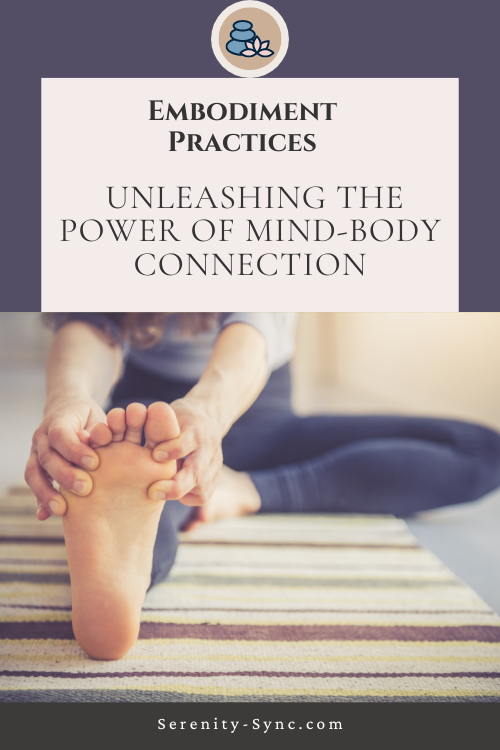In Brief
Embodiment practices are a transformative approach that merges the mind and body, fostering self-awareness, empowerment, and holistic healing. In today’s fast-paced world, where we are often disconnected from our bodies, these practices offer a pathway to reclaiming our physicality and finding balance. From somatic therapy to breathwork, these techniques enhance our well-being, improve mental health, and deepen our understanding of ourselves. Embodiment practices are like a secret weapon, helping us tap into our innate power and unlocking a world of possibilities.

Your Free PDF version of this blog post Awaits – No Strings, Just Click and Enjoy! 🌸🎁
Introduction to Embodiment Practices
Indeed, embodiment practices are a dynamic and holistic approach that combines the power of the mind and body. They involve various techniques such as somatic therapy, breathwork, and movement to cultivate self-awareness, enhance well-being, and promote healing. The mind-body connection is at the heart of embodiment practices, recognizing that our mental and emotional states can profoundly impact our physical sensations and vice versa.
In addition, embodiment practices hold great significance in our modern world, where we often find ourselves disconnected from our bodies due to the demands of technology, sedentary lifestyles, and an overemphasis on intellectual pursuits. These practices offer a way to reestablish a harmonious relationship with our bodies and tap into the wisdom they hold. By becoming more attuned to our physical sensations, we can uncover valuable insights about ourselves, improve our mental and physical well-being, and make more informed choices in our lives.
Furthermore, embodiment practices bring a multitude of benefits to those who engage in them. They help us develop a deeper understanding of ourselves, foster self-acceptance and self-compassion, and promote emotional regulation. These practices also enable us to release tension and stress from our bodies, improve our posture and movement, and enhance our overall physical vitality. By harnessing the power of the mind-body connection, embodiment practices empower us to live more fulfilling and authentic lives.
Fun Fact
Did you know that embodiment practices have been used for centuries in various cultures? From yoga in India to martial arts in China, these practices have long recognized the power of the mind-body connection.
The Importance of Body Awareness in Today’s World
In today’s screen-dominated world, where we spend countless hours hunched over our devices, it’s easy to become disconnected from our bodies. This lack of body awareness can have detrimental effects on our overall well-being. When we are unaware of our physical sensations, we are more likely to neglect our bodies’ needs, leading to imbalances, chronic pain, and a sense of disconnection from ourselves.
Cultivating body awareness is crucial for maintaining our overall health and well-being. It allows us to tune into our bodies’ signals and respond to them appropriately. By paying attention to our physical sensations, we can identify areas of tension, discomfort, or fatigue and take proactive steps to address them. Body awareness also helps us recognize the impact of our emotions and thoughts on our physical state, enabling us to develop healthier coping mechanisms and self-regulation skills.
Also, a lack of body awareness can have profound consequences for our mental and emotional well-being. When we are disconnected from our bodies, we may struggle with low self-esteem, body image issues, and difficulties in managing stress and anxiety. By cultivating body awareness, we can develop a more positive and compassionate relationship with ourselves, promoting mental and emotional resilience.
Embodiment Practices in Research: Insights from Anorexia Nervosa
In addition, Anorexia nervosa, a complex eating disorder, provides valuable insights into the role of embodiment in our relationship with our bodies. Also, individuals with anorexia nervosa often have a distorted body image and struggle with embracing their physical selves. Embodiment practices have shown promise in supporting individuals with anorexia nervosa in reconnecting with their bodies and fostering a healthier body image.
Furthermore, research has demonstrated a strong connection between body image and embodiment. When individuals are disconnected from their bodies, they may perceive themselves inaccurately, leading to body dissatisfaction and disordered eating behaviors. Embodiment practices, such as somatic therapy and body-based interventions, help individuals with anorexia nervosa develop a more accurate perception of their bodies and rebuild a compassionate relationship with themselves.
Finally, eEmbodiment practices have been found to be effective in treating disordered eating by addressing the underlying psychological and emotional factors that contribute to the development and maintenance of these behaviors. By integrating the mind and body, individuals can cultivate a sense of wholeness and balance, reducing the need for destructive coping mechanisms like disordered eating.
Embodiment Practices in Somatic Therapy: Bridging the Mind-Body Interface
Indeed, somatic therapy is a form of psychotherapy that places a strong emphasis on the mind-body connection. It recognizes that trauma and emotional distress are not solely psychological experiences but also manifest in the body. Somatic therapists utilize various embodiment practices to facilitate healing, promote resilience, and restore the mind-body connection.
Furthermore, somatic therapy incorporates techniques such as breathwork, somatic movement, and body-centered awareness to help individuals release stored tension, process traumatic memories, and develop greater self-regulation. These practices engage the body’s innate capacity for healing and provide a safe container for exploring and integrating challenging emotions and experiences.
Embodiment practices in somatic therapy have proven particularly effective in treating trauma and post-traumatic stress disorder (PTSD). By working through traumatic memories and sensations in a somatic context, individuals can gradually release the grip of trauma on their bodies and minds. Somatic experiencing, a specific approach within somatic therapy, focuses on renegotiating the body’s responses to trauma, empowering individuals to reclaim their sense of safety and agency.
The Aim of Somatic Therapy: Holistic Healing and Self-Transformation
In addition, somatic therapy recognizes the intricate connection between the mind and body. It focuses on the physical sensations and experiences within the body to address emotional and psychological issues. By bringing attention to the body and its sensations, somatic therapy aims to achieve holistic healing and self-transformation.
How somatic therapy addresses the mind-body interface
In addition, somatic therapy acknowledges the concept of embodied cognition, which suggests that our thoughts and emotions are influenced by our physical experiences. By engaging with the body, somatic therapy provides a pathway to access and process emotions that may be stored in the body. Through various techniques and practices, individuals can develop a deeper understanding of their physical and emotional states, leading to improved mental well-being.
The power of embodiment practices in enhancing self-awareness
Embodiment practices such as somatic movement and the Feldenkrais Method are integral to somatic therapy. These practices help individuals become more attuned to their body sensations and gain a heightened sense of body awareness. By cultivating body awareness, individuals can better understand their physical and emotional needs, leading to increased self-regulation and empowerment.
Achieving holistic healing through somatic therapy
In addition, somatic therapy has shown promising results in various areas, including PTSD treatment, disordered eating, and SE-AN (severe and enduring anorexia nervosa). By addressing traumatic memories and rewiring mental and physical habits, somatic therapy offers a comprehensive approach to healing. It aims to restore balance, promote vulnerability, and reconnect individuals with their innate capacity for wholeness.
Incorporating Breathwork: Harnessing the Life Force Within
Breathwork, a fundamental aspect of somatic therapy, plays a crucial role in harnessing the life force within. Through the practice of pranayama, individuals can tap into the power of their breath to enhance their physical and energetic states.
Introduction to Prana and Pranayama (breathwork)
Furthermore, In many cultures, including those in India and China, the concept of prana (the life force) and pranayama
(breathwork) has been recognized for centuries. Breathwork involves conscious manipulation of the breath to
influence the flow of prana in the body. This practice aims to balance the body’s energy and promote a sense of harmony.
Exploring the physical and energetic effects of breathwork
Scientific studies have shown that breathwork can have profound effects on the body and mind. It has been proven to reduce cortisol levels, the stress hormone, and improve circulation. Breathwork acts as a natural mood booster, helping individuals feel more energized and calm. By focusing on the breath, individuals can regulate their physiological responses and create a sense of inner balance.
Using breathwork as an active meditation for emotional release
Breathwork can also serve as an active meditation practice, allowing individuals to release stored emotions and access a deeper level of self-awareness. By consciously breathing and directing their breath to parts of the body that hold tension, individuals can facilitate emotional release and gain insights into their emotional patterns. Breathwork offers a powerful tool for emotional healing and personal transformation.
Conclusion
Embarking on a journey of somatic therapy and incorporating breathwork can lead to profound holistic healing and self-transformation. By recognizing the mind-body connection and utilizing embodiment practices, individuals can tap into their physical and emotional experiences, release trauma, and achieve a state of balance and wholeness. Somatic therapy offers a pathway to self-awareness, empowerment, and the restoration of mind-body harmony. So, take a deep breath, embrace the power of your body, and embark on a transformative journey to holistic healing.
Fun Fact
Did you know that embodiment practices have been used for centuries in various cultures? From yoga in India to martial arts in China, these practices have long recognized the power of the mind-body connection.

